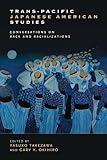Trans-Pacific Japanese American Studies : Conversations on Race and Racializations / ed. by Gary Y. Okihiro, Yasuko Takezawa.
Material type: TextPublisher: Honolulu : University of Hawaii Press, [2016]Copyright date: ©2016Description: 1 online resource (456 p.) : 17 color, 7 b&w illustrationsContent type:
TextPublisher: Honolulu : University of Hawaii Press, [2016]Copyright date: ©2016Description: 1 online resource (456 p.) : 17 color, 7 b&w illustrationsContent type: - 9780824847586
- 9780824867621
- 973/.04956 23
- E184.J3 T73 2016eb
- online - DeGruyter
- Issued also in print.
| Item type | Current library | Call number | URL | Status | Notes | Barcode | |
|---|---|---|---|---|---|---|---|
 eBook
eBook
|
Biblioteca "Angelicum" Pont. Univ. S.Tommaso d'Aquino Nuvola online | online - DeGruyter (Browse shelf(Opens below)) | Online access | Not for loan (Accesso limitato) | Accesso per gli utenti autorizzati / Access for authorized users | (dgr)9780824867621 |
Frontmatter -- Contents -- Note to the Reader -- Acknowledgments -- TRANS-PACIFIC Japanese American Studies -- Introduction -- PART I: ORIENTATION -- CHAPTER 1: Shifting Grounds in Japanese American Studies Reconsidering "Race" and "Class" in a Trans-Pacific Geopolitical-Historical Context -- PART II: RACIALIZATIONS -- CHAPTER 2: The Unbearable Whiteness of Being The Contemporary Racialization of Japanese/ Asian Americans -- CHAPTER 3: Negotiating Categories and Transgressing (Mixed-) Race Identities The Art and Narratives of Roger Shimomura, Laura Kina, and Shizu Saldamando -- PART III: COMMUNITIES -- CHAPTER 4: Trans-Pacific Localism and the Creation of a Fishing Colony Pre-World War II Taiji Immigrants on Terminal Island, California -- CHAPTER 5: Vernacular Representations of Race and the Making of a Japanese Ethnoracial Community in Los Angeles -- CHAPTER 6: Negotiating the Boundaries of Race, Caste, and Mibun Meiji-era Diplomatic and Immigrant Responses to North American Categories of Exclusion -- PART IV: INTERSECTIONS -- CHAPTER 7: Americanization and Beika Gender and Racialization of the Issei Community in California before World War II -- CHAPTER 8: Sansei Women and the Gendering of Yellow Power in Southern California, 1960s-1970s -- PART V: BORDERLANDS -- CHAPTER 9: Nakayoshi Group Postwar Okinawan Women's Articulation of Identity in America -- CHAPTER 10: What Brings Korean Immigrants to Japantown? Commodifying Racial Differences in the Age of Globalization -- PART VI: REORIENTATIONS -- CHAPTER 11: The Making of a Japanese American Race, and Why Are There No "Immigrants" in Postwar Nikkei History and Community? The Problems of Generation, Region, and Citizenship in Japanese America -- CHAPTER 12: Reorienting Asian American Studies in Asia and the Pacific -- PART VII: PEDAGOGIES -- CHAPTER 13: Teaching Asian American Studies in Japan Challenges and Possibilities -- CHAPTER 14: Japanese American Progressives A Case Study in Identity Formation -- PART VIII: DIALOGUING SUBJECT POSITIONS -- Notes from Shinagawa, July 28-29, 2012 -- Thoughts on Positionality -- Asian American History across the Pacific -- Japanese Americans in Academia and Political Discourse in Japan -- Location, Positionality, and Community Studying and Teaching Japanese America in the United States and Japan -- Positions In-Between Hapa, Buddhist, and Japanese American Studies -- Toward More Equal Dialogue -- Contributors -- Index
restricted access online access with authorization star
http://purl.org/coar/access_right/c_16ec
Trans-Pacific Japanese American Studies is a unique collection of essays derived from a series of dialogues held in Tokyo, Kyoto, and Los Angeles on the issues of racializations, gender, communities, and the positionalities of scholars involved in Japanese American studies. The book brings together some of the most renowned scholars of the discipline in Japan and North America. It seeks to overcome past constraints of dialogues between Japan- and U.S.-based scholars by providing opportunities for candid, extended conversations among its contributors.While each contribution focuses on the field of "Japanese American" studies, approaches to the subject vary-ranging from national and village archives, community newspapers, personal letters, visual art, and personal interviews. Research papers are divided into six sections: Racializations, Communities, Intersections, Borderlands, Reorientations, and Teaching. Papers by one or two Japan-based scholar(s) are paired with a U.S.-based scholar, reflecting the book's intention to promote dialogue and mutuality across national formations. The collection is also notable for featuring underrepresented communities in Japanese American studies, such as Okinawan "war brides," Koreans, women, and multiracials. Essays on subject positions raise fundamental questions: Is it possible to engage in a truly equal dialogue when English is the language used in the conversation and in a field where English-language texts predominate? How can scholars foster a mutual respect when U.S.-centrism prevails in the subject matter and in the field's scholarly hierarchy? Understanding foundational questions that are now frequently unstated assumptions will help to disrupt hierarchies in scholarship and work toward more equal engagements across national divides. Although the study of Japanese Americans has reached a stage of maturity, contributors to this volume recognize important historical and contemporary neglects in that historiography and literature. Japanese America and its scholarly representations, they declare, are much too deep, rich, and varied to contain in a singular narrative or subject position.
Issued also in print.
Mode of access: Internet via World Wide Web.
In English.
Description based on online resource; title from PDF title page (publisher's Web site, viewed 29. Jul 2021)


